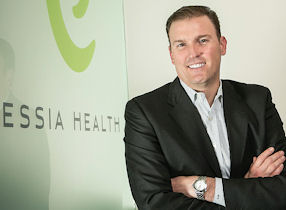Doctors can’t examine a patient and type on a computer keyboard at the same time. That statement underlies the business model of Essia Health, a three-year-old Portland, Ore. company that recently changed its name from Scribes STATS after opening a second office in Woodland Hills, where its new chief executive is now based. The company’s core business is supplying medical scribes to hospitals, clinics and doctor offices. The scribes work one-on-one with doctors; while the doctor interacts with a patient, the scribe inputs information on the computer. Most doctors have several exam rooms, so the scribe comes with a laptop on a cart and follows the doctor from patient to patient. But another fast-growing and potentially more lucrative business is providing electronic medical records, or EMR, technicians to hospitals. The techs help doctors and nurses know how to navigate new medical software programs. “The name change was driven by the idea that our business is broader than medical scribes,” said Chief Executive Matthew Kirchner. “We wanted a name that didn’t indicate one business line or another so if there are other service lines in the future, we wanted a name we could market effectively.” Kirchner was brought in to fuel growth beyond the scribes business line, where Essia competes against companies large and small, following a $6 million investment last year lead by Baltimore, Md. private equity firm Camden Partners Holdings LLC. A former marketing executive at Medtronic Inc.’s insulin pump division in Northridge, Kirchner took the job but wanted to stay in the Valley, even though the company is still headquartered in Portland. That’s where founder and emergency room doctor Kathleen Myers remains as its chief medical officer. Since taking over in June, Kirchner has worked to fill out the management team, hiring a chief financial officer and vice presidents of operations, human resources and business development, all of whom work out of Warner Center. The company has about 500 employees in 14 states, and most are scribes. The typical cost for a scribe is $20 to $50 an hour. “Medical scribes were the genesis of the business because we recognized the challenge of trying to interact with a patient and typing at same time,” said Kirchner. Dr. Kaveh Safavi, global health leader at consulting firm Accenture in Chicago, said on average, for every dollar a hospital or clinic spends on software, it will spend $1 to $2 on support services offered by companies such as Essia. In a recent report, Safavi estimated the U.S. market for EMR software at $9.3 billion with a projected annual growth rate of 7.1 percent. For support companies, the challenge is to adapt as the market changes. Market adaptation While the long-term goal of computerized records is to make health care more efficient, having a scribe with every doctor makes it less efficient. So many EMR developers are trying to solve that problem with everything from voice recognition software to simplified data input. “There is an evolution around usability,” Safavi said. “And the goal is to substitute technology for labor.” Of course, any viable solution would cut into Essia’s core business, so one way the company is trying to adapt is by rapidly growing the EMR technician side of its business. Kirchner said the company’s revenue is roughly split 50-50 between the scribe business and the technician service. However, he expects the EMR part will grow as the software systems become more sophisticated. While it’s commonplace for desktop operating systems and programs to get updated every few years, that replacement cycle is just beginning for EMR. “Every customer is aware that this is not a one-time event,” Kirchner said. “It’s a lifetime commitment. Our challenge is to solve other future problems in that dynamic. The issue is how do you evolve or move to higher value services.” Kirchner said large software providers install a new system based on a “train the trainers” model. In other words, the company will train a few people, who then will train all the other workers at the hospital. “That’s a really challenging model to pull off with a complex software system,” Kirchner said. “We augment the hospital’s trainers with other people to help.” Usually one Essia technician is assigned for each department in the hospital, such as the emergency room or the maternity ward. They stay on site for anywhere from two weeks to three months. EMR technicians cost the hospital anywhere from $50 to $300 an hour. Dr. Randale Sechrest, a regional chief medical information officer in Missoula, Mont. for Providence Health & Services, has used Essia’s technician service for software installations at 26 hospitals and more than 300 clinics. He said one reason for the relationship is the cost-effectiveness of Essia’s service. “They have managed to assemble a team of young, tech-savvy tutors,” Sechrest said. “Their model is to bring in college students who are interested in health careers. So they have interest in the industry and they are technically astute.”
